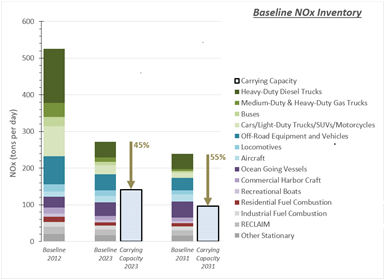The 2016 Air Quality Management Plan (AQMP) demonstrates how the region will meet federal air quality standards for ozone and particulate matter. The AQMP is a component of the State Implementation Plan (SIP) that the California Air Resources Board submits to U.S. EPA for review and approval under the Clean Air Act. The AQMP included a year 2012 baseline emissions inventory based on existing regulations and activity levels and also estimated future year inventories based on projected emission reductions from existing regulations (see graph below). This graph also shows air basin carrying capacities, or the daily maximum level of NOx that can be emitted while still attaining federal air quality standards. The control strategy within the 2016 AQMP identifies how the region will reduce emissions by 45% and 55% in 2023 and 2031, respectively.

The 2016 AQMP control strategy describes many future regulations that are designed to achieve emission reductions that can be credited towards the State Implementation Plan (SIP). While regulations are the traditional approach to obtaining ‘SIP credit’, there are other potential mechanisms available. Potential examples of other approaches could include financial incentives for near-zero and zero emission technologies, or previous or future voluntary commitments made to achieve emission reductions separate from regulations from U.S. EPA, CARB, or South Coast AQMD. In order to obtain SIP credit for these other mechanisms, the emission reductions must be shown to be permanent, enforceable, quantifiable, and surplus as defined by U.S. EPA.
Staff will be developing guidance to ensure that emission reductions achieved outside of a traditional regulatory approach can be credited toward the SIP, thus reducing the amount of emission reductions needed through a regulatory program. More information on South Coast AQMD guidance will be provided as it becomes available.
General Reference Documents Available from U.S. EPA on Obtaining SIP Credit